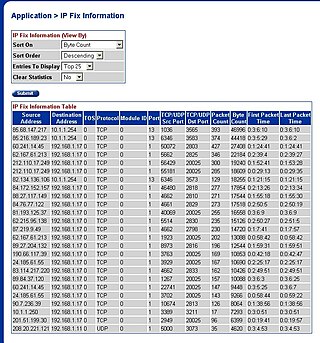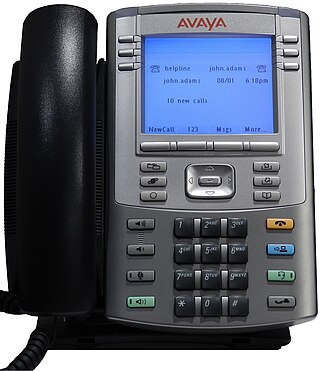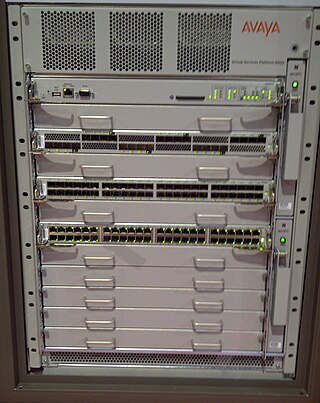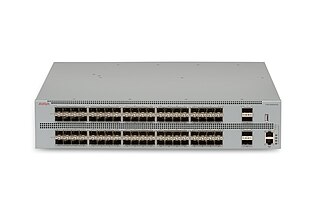Bay Networks, Inc., was a network hardware vendor formed through the merger of Santa Clara, California, based SynOptics Communications and Billerica, Massachusetts based Wellfleet Communications on July 6, 1994. SynOptics was an important early innovator of Ethernet products, having developed a pre-standard twisted pair 10Mbit/s Ethernet product and a modular Ethernet hub product that dominated the enterprise networking market. Wellfleet was an important competitor to Cisco Systems in the router market, ultimately commanding up to a 20% market share of the network router business worldwide. The combined company was renamed Bay Networks as a nod to the legacy that SynOptics was based in the San Francisco area and Wellfleet was based in the Boston area, two cities well known for their bays.

Multi-link trunking (MLT) is a link aggregation technology developed at Nortel in 1999. It allows grouping several physical Ethernet links into one logical Ethernet link to provide fault-tolerance and high-speed links between routers, switches, and servers.
InterSwitch Trunk (IST) is one or more parallel point-to-point links that connect two switches together to create a single logical switch. The IST allows the two switches to share addressing information, forwarding tables, and state information, permitting rapid fault detection and forwarding path modification. The link may have different names depending on the vendor. For example, Brocade calls this an Inter-Chassis Link (ICL). Cisco calls this a VSL.

Metro Ethernet Routing Switch 8600 or MERS 8600 is a modular chassis router and/or switch manufactured by Nortel now acquired by Ciena. The MERS 8600 supports the Provider Backbone Bridges (PBB), Provider Backbone Transport (PBT) technologies and carrier class Operations Administration & Maintenance (OAM) tools.

The Ethernet Routing Switch 5500 Series or is a series of stackable, Layer 3 switches used in computer networking. The ERS 5000 was originally designed by Nortel and is now manufactured by Avaya. Up to 8 ERS 5000 Series Switches may be stacked in a 640 Gbit/s fast stacking configuration. This Switch was used as the access layer device for the 2010 Winter Olympics games. The 817 Access Switches supported 8782 Voice-over-IP telephones.

Avaya IP Phone 1140E in telecommunications is a desktop Internet Protocol client from 1100-series manufactured by Avaya for unified communications. The phone can operate on the Session Initiation Protocol (SIP) or UNIStim protocols. The SIP firmware supports presence selection and notification along with secure instant messaging. This device has an integrated 10/100/1000BASE-T auto-sensing Ethernet switch with two ports and an integrated USB port, and is Bluetooth capable. The SIP version of this phone has full IPv6 functionality and only requires 2.9 watts of power.
The Avaya Secure Router 4134, in telecommunications and computer networking technologies, is a device manufactured by Avaya that combines the functions of WAN Routing, stateful firewall security, Ethernet switching, IP telephony, and Microsoft mediation into one device. In addition to sharing many features with other routers such as VRRP, MPLS, and hot-switchable modules, the SR-4134 also guards against individual circuit failures, has the ability to recover from device failures in less than a second, and instantly restores bandwidth once a connection has been repaired. The system is very energy-efficient and can save the owner as much as 40% on energy total cost of ownership, according to testing by the Tolly Group. In July 2011, it was integrated with the Silver Peak WAN optimization appliance to optimize the performance of enterprise voice, video, and unified communications (UC), to ensure that remote users have fast and reliable access to all centralized applications.
Simple Loop Prevention Protocol (SLPP) in computer networking is a data link layer protocol developed by Nortel to protect against Layer 2 network loops. SLPP uses a small hello packet to detect network loops. The SLPP protocol checks packets from the originating switch and the peer switch in a SMLT configuration. Sending hello packets on a per VLAN basis allows SLPP to detect VLAN based network loops for un-tagged as well as tagged IEEE 802.1Q VLAN link configurations. If a loop is detected, the associated port is shut down.

Ethernet Routing Switch 5600 Series or in computer networking terms are stackable routers and switches designed and manufactured by Avaya. The ERS 5600 Switches can be stacked up to 8 units high to create a 1.152 Tbit/s backplane through the Flexible Advanced Stacking Technology (FAST) stacking technology configuration. The 5600 Series consists of five stackable models that can be mixed and matched together with other ERS 5600 models or other ERS 5500 models to meet configuration requirements. Additionally the ports on the switches incorporates the Avaya Energy Saver (AES) which can manage and dim down the power requirements to save energy across all switches in the enterprise.

Avaya Virtual Services Platform 9000 Series or VSP 9000 is a set of modular chassis switches used in enterprise and data center networks, manufactured by Avaya. The VSP 9000 is used by institutions which are suffering from performance limitations, need to simplify their network infrastructure in a virtualized environment, or require 10 Gigabit Ethernet today with the option to scale to 40 or 100 Gigabit Ethernet in the future. It is also an option for companies who are looking to reduce the power and cooling cost in order to maximize the cost-effectiveness of their infrastructures; this unit was also designed and is expected to have a lifespan of seven-to-ten years. In 2013 the Olympics network backbone is built with VSP 9000 Switches supporting 30,000 users and up to 54 terabits per second of traffic.
Avaya Ethernet Routing Switch 8800 Series or ERS 8800, is a range of modular chassis products that combine hardware router and switch used in computer networking, designed and manufactured by Avaya. When an ERS 8000 Chassis, a passive device in its own right, is equipped with the 8895 SF/CPU, this system is known as an Ethernet Routing Switch 8800; conversely, when equipped with an 8692 SF/CPU module the system is known as an Ethernet Routing Switch 8600.

Avaya 9600-series IP deskphones are 15 different desk handset devices that are used for unified communications. The phones are compatible with the Avaya Aura platform of products and IP office systems. The systems add high-quality voice codecs like the G.722 codec and new menus over older IP phone series. The 9620 includes 16 MB of flash memory and the 9630 includes 32 MB of flash memory.
The 1100-series IP phones are 6 different desktop IP clients manufactured by Avaya for Unified communications which can operate on the SIP or UNIStim protocols. The SIP Firmware supports presence selection and notification along with secure instant messaging.
Avaya Virtual Services Platform 7000 Series or VSP 7000 is a set standalone/Stackable Switches, used in enterprise data networks, and data centers, manufactured by Avaya. This product is primarily offered to satisfy the Top-of-Rack (ToR) role for server farms and virtualized data centers. It supports Avaya's extended Shortest Path Bridging (SPB) implementation "Fabric Connect", and is future-ready for Edge Virtual Bridging (EVB) – IEEE 802.1Qbg, and Fiber Channel over Ethernet (FCoE). The system incorporates fifth generation application-specific integrated circuit (ASIC) chips with redundant and hot-swappable power supplies, fans, and expansion modules. The VSP 7000's unique architecture allows it to be meshed—fully or partially—with like devices, creating a high-capacity, low-latency network of up to 500 units, supporting up to 16,000 ports of 10GbE supported by a virtual backplane of up to 280 Tbit/s

Ethernet routing switch 4000 series or in computer networking terms are stackable layer-3 (routers) and layer-2 (switches) designed and manufactured by Avaya for Ethernet devices. The ERS 4000 series consists of two major groups of devices, the ERS 4500 models and the ERS 4800 models.
Fabric Connect, in computer networking usage, is the name used by Extreme Networks to market an extended implementation of the IEEE 802.1aq and IEEE 802.1ah-2008 standards.

Ethernet Routing Switch 3500 series and Ethernet Routing Switch 2500 series or ERS 3500 and ERS 2500 in data computer networking terms are stackable routing switches designed and manufactured by Avaya.

The Avaya Virtual Services Platform 8000 Series, or VSP 8000, is a standalone Ethernet Switch, manufactured by Avaya and intended for use in Campus network and Data Center deployment scenarios.














